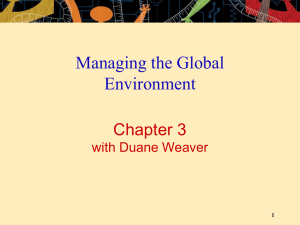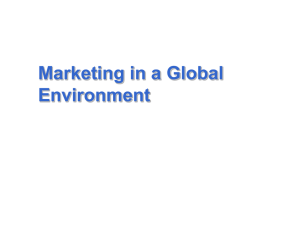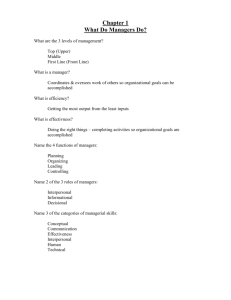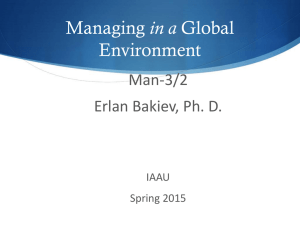Management Concepts: Parochialism, Planning, Competitive Advantage
advertisement
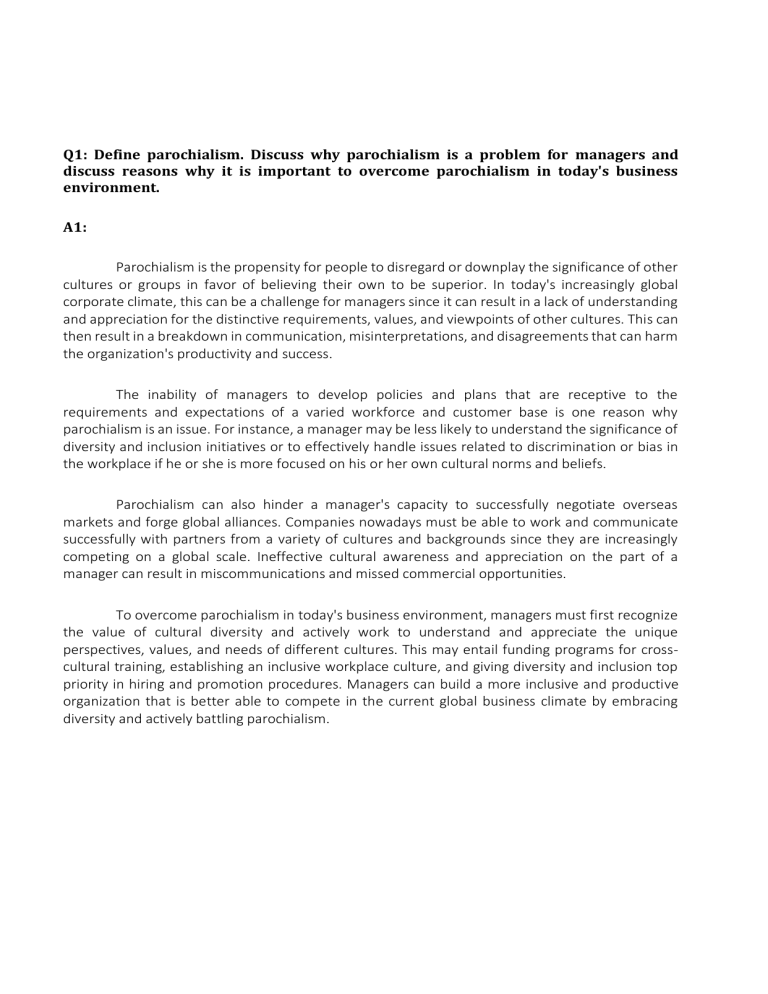
Q1: Define parochialism. Discuss why parochialism is a problem for managers and discuss reasons why it is important to overcome parochialism in today's business environment. A1: Parochialism is the propensity for people to disregard or downplay the significance of other cultures or groups in favor of believing their own to be superior. In today's increasingly global corporate climate, this can be a challenge for managers since it can result in a lack of understanding and appreciation for the distinctive requirements, values, and viewpoints of other cultures. This can then result in a breakdown in communication, misinterpretations, and disagreements that can harm the organization's productivity and success. The inability of managers to develop policies and plans that are receptive to the requirements and expectations of a varied workforce and customer base is one reason why parochialism is an issue. For instance, a manager may be less likely to understand the significance of diversity and inclusion initiatives or to effectively handle issues related to discrimination or bias in the workplace if he or she is more focused on his or her own cultural norms and beliefs. Parochialism can also hinder a manager's capacity to successfully negotiate overseas markets and forge global alliances. Companies nowadays must be able to work and communicate successfully with partners from a variety of cultures and backgrounds since they are increasingly competing on a global scale. Ineffective cultural awareness and appreciation on the part of a manager can result in miscommunications and missed commercial opportunities. To overcome parochialism in today's business environment, managers must first recognize the value of cultural diversity and actively work to understand and appreciate the unique perspectives, values, and needs of different cultures. This may entail funding programs for crosscultural training, establishing an inclusive workplace culture, and giving diversity and inclusion top priority in hiring and promotion procedures. Managers can build a more inclusive and productive organization that is better able to compete in the current global business climate by embracing diversity and actively battling parochialism. Q2: List and discuss the three attitudes’ managers might have toward international business A2: The first attitude is the ethnocentric attitude, and it is the conviction that one's own culture and ways of doing things are better than those of other nations. Managers with an ethnocentric mindset could be unwilling to adopt or even explore different cultural practices. With coworkers and clients from other cultures, this approach may cause communication problems and misunderstandings. The second attitude is the polycentric attitude, in which managers respect cultural differences and see each nation in which their company has a presence as a distinct market. Polycentric managers support indigenous practices and provide local communities a lot of local authority. A polycentric strategy runs the risk of losing intercultural synergy and creating a lack of consistency among worldwide subsidiaries, but it can help businesses adapt to local conditions and win customers' trust. The third attitude is the geocentric attitude, which focuses on finding the best person for the job, regardless of their nationality or background. Geocentric managers may adopt a "think global, act local" philosophy and see the organization as a cohesive, single unit. This mentality values the diversity of viewpoints, cultural backgrounds, and national origins, which can aid businesses in conducting business internationally and preserving a consistent brand image around the world. In conclusion, the geocentric perspective on global business is widely seen as the most successful. It values discovering, recruiting, and promoting the best competent individuals possible regardless of where they come from and acknowledges that diversity in the workplace can be a huge benefit. To succeed in international company, managers should be open-minded, culturally aware, and sensitive to cultural differences. However, depending on the situation, each attitude type may have advantages and disadvantages. Q3: In a short essay, discuss the three planning contingency factors that influence the choice of plans and illustrate how these factors influence planning. A3: The first planning contingency factor is environmental uncertainty, which refers to the degree of predictability or stability in the organization's operating environment. Managers are more inclined to use flexible strategies that can be modified as circumstances change in high uncertainty settings. Longer-term plans, on the other hand, might be more appropriate in situations that are more stable. A well-established company in a stable market may rely on more conventional, long-term planning, whereas a startup in a constantly changing industry may need to be adaptable and have backup plans ready to change the course of their product. The second factor is organizational complexity, which refers to the level of complication in an organization's structure, systems, and processes. Planning becomes increasingly difficult as organizations become more complicated. Managers may use more organized plans in these circumstances to guarantee that all areas of the organization are in sync. Managers may need to coordinate sales, marketing, and production across several nations and time zones in a large, international corporation, for instance. To ensure that every part of the organization is appropriately considered in this situation, organized planning might be required. The third factor is crisis or urgency, which refers to situations where immediate action is necessary to prevent a negative outcome, such as a natural disaster or a cyberattack. Managers must rely on prepared contingency plans that outline the precise crisis response measures in these circumstances. For instance, a business might have a strategy in place for an emergency reaction in the event of a pandemic or other catastrophe. In conclusion, these variables affect planning because they aid managers in determining the degree of complexity, ambiguity, and urgency existing in the environment of the firm. Managers can create successful strategies that are more adapted for the difficulties they confront by considering these eventualities, boosting the likelihood of organizational success. It's critical to understand that these variables may overlap and are not exclusive of one another, which makes planning more complex and difficult. In general, it is essential to comprehend planning contingency aspects in order to create flexible, adaptive plans that may be responsive to shifting conditions and enhance organizational performance. Q4: Discuss the concept of competitive advantage and explain how quality is a competitive advantage. A4: Competitive advantage refers to the factors that allow a company to produce goods or services better or more cheaply than its competitors. It is what distinguishes a business from rivals and offers it a competitive edge. Different strategies, such as cost structure, innovation, branding, customer service, and intellectual property, can be used to gain a competitive edge. For a business, quality can be a competitive advantage. A corporation can stand out from its rivals by providing top-notch goods or services that draw in and keep customers. A comprehensive component of a company's overall competitive advantage strategy can be described as quality. By prioritizing quality, a company can reap many benefits. For example, satisfied customers are likely to return and even recommend the company's products or services to others. Additionally, quality can reduce costs over time as there will be fewer returns, repairs, or replacements required. A company that prioritizes quality can also build a positive reputation and brand image, which can further enhance its competitive advantage. In conclusion, quality can be a crucial factor in a company's competitive advantage. By providing high-quality products or services, a company can attract and retain customers, build brand loyalty, and ultimately set itself apart from the competition.
